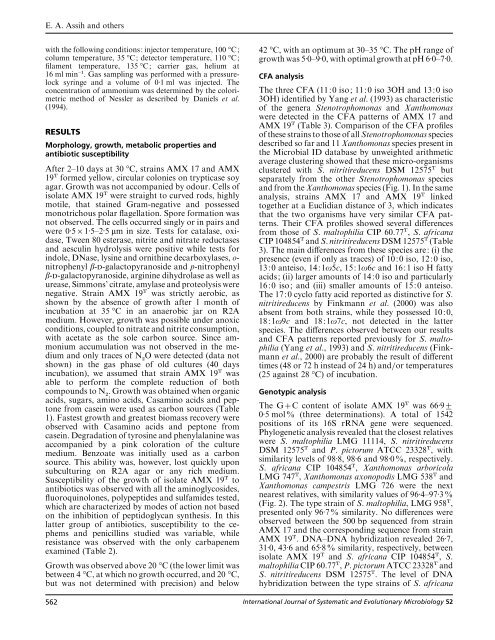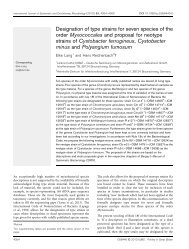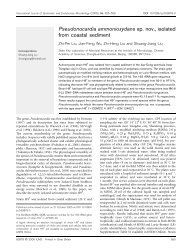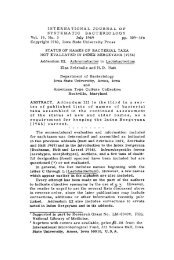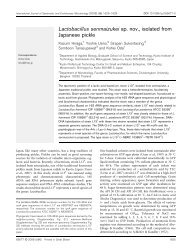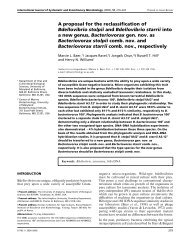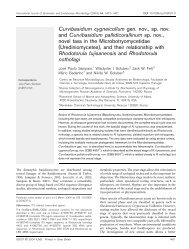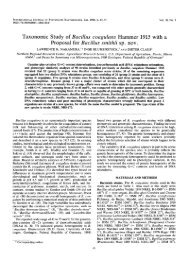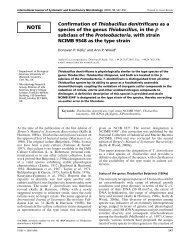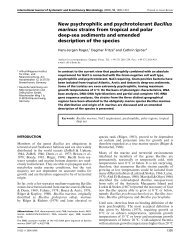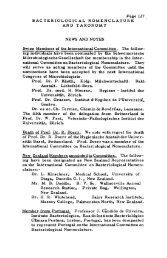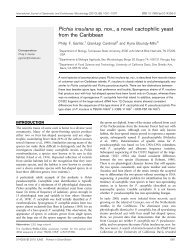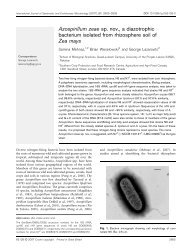Stenotrophomonas acidaminiphila sp. nov., a strictly aerobic ...
Stenotrophomonas acidaminiphila sp. nov., a strictly aerobic ...
Stenotrophomonas acidaminiphila sp. nov., a strictly aerobic ...
Create successful ePaper yourself
Turn your PDF publications into a flip-book with our unique Google optimized e-Paper software.
E. A. Assih and others<br />
with the following conditions: injector temperature, 100 C;<br />
column temperature, 35 C; detector temperature, 110 C;<br />
filament temperature, 135 C; carrier gas, helium at<br />
16 ml min−. Gas sampling was performed with a pressurelock<br />
syringe and a volume of 01 ml was injected. The<br />
concentration of ammonium was determined by the colorimetric<br />
method of Nessler as described by Daniels et al.<br />
(1994).<br />
RESULTS<br />
Morphology, growth, metabolic properties and<br />
antibiotic susceptibility<br />
After 2–10 days at 30 C, strains AMX 17 and AMX<br />
19T formed yellow, circular colonies on trypticase soy<br />
agar. Growth was not accompanied by odour. Cells of<br />
isolate AMX 19T were straight to curved rods, highly<br />
motile, that stained Gram-negative and possessed<br />
monotrichous polar flagellation. Spore formation was<br />
not observed. The cells occurred singly or in pairs and<br />
were 0515–25 µm in size. Tests for catalase, oxidase,<br />
Tween 80 esterase, nitrite and nitrate reductases<br />
and aesculin hydrolysis were positive while tests for<br />
indole, DNase, lysine and ornithine decarboxylases, onitrophenyl<br />
β-d-galactopyranoside and p-nitrophenyl<br />
β-d-galactopyranoside, arginine dihydrolase as well as<br />
urease, Simmons’ citrate, amylase and proteolysis were<br />
negative. Strain AMX 19T was <strong>strictly</strong> <strong>aerobic</strong>, as<br />
shown by the absence of growth after 1 month of<br />
incubation at 35 C in an an<strong>aerobic</strong> jar on R2A<br />
medium. However, growth was possible under anoxic<br />
conditions, coupled to nitrate and nitrite consumption,<br />
with acetate as the sole carbon source. Since ammonium<br />
accumulation was not observed in the medium<br />
and only traces of N O were detected (data not<br />
shown) in the gas phase<br />
<br />
of old cultures (40 days<br />
incubation), we assumed that strain AMX 19T was<br />
able to perform the complete reduction of both<br />
compounds to N . Growth was obtained when organic<br />
acids, sugars, amino<br />
<br />
acids, Casamino acids and peptone<br />
from casein were used as carbon sources (Table<br />
1). Fastest growth and greatest biomass recovery were<br />
observed with Casamino acids and peptone from<br />
casein. Degradation of tyrosine and phenylalanine was<br />
accompanied by a pink coloration of the culture<br />
medium. Benzoate was initially used as a carbon<br />
source. This ability was, however, lost quickly upon<br />
subculturing on R2A agar or any rich medium.<br />
Susceptibility of the growth of isolate AMX 19T to<br />
antibiotics was observed with all the aminoglycosides,<br />
fluoroquinolones, polypeptides and sulfamides tested,<br />
which are characterized by modes of action not based<br />
on the inhibition of peptidoglycan synthesis. In this<br />
latter group of antibiotics, susceptibility to the cephems<br />
and penicillins studied was variable, while<br />
resistance was observed with the only carbapenem<br />
examined (Table 2).<br />
Growth was observed above 20 C (the lower limit was<br />
between 4 C, at which no growth occurred, and 20 C,<br />
but was not determined with precision) and below<br />
42 C, with an optimum at 30–35 C. The pH range of<br />
growth was 50–90, with optimal growth at pH 60–70.<br />
CFA analysis<br />
The three CFA (11:0 iso; 11:0 iso 3OH and 13:0 iso<br />
3OH) identified by Yang et al. (1993) as characteristic<br />
of the genera <strong>Stenotrophomonas</strong> and Xanthomonas<br />
were detected in the CFA patterns of AMX 17 and<br />
AMX 19T (Table 3). Comparison of the CFA profiles<br />
of these strains to those of all <strong>Stenotrophomonas</strong> <strong>sp</strong>ecies<br />
described so far and 11 Xanthomonas <strong>sp</strong>ecies present in<br />
the Microbial ID database by unweighted arithmetic<br />
average clustering showed that these micro-organisms<br />
clustered with S. nitritireducens DSM 12575T but<br />
separately from the other <strong>Stenotrophomonas</strong> <strong>sp</strong>ecies<br />
and from the Xanthomonas <strong>sp</strong>ecies (Fig. 1). In the same<br />
analysis, strains AMX 17 and AMX 19T linked<br />
together at a Euclidian distance of 3, which indicates<br />
that the two organisms have very similar CFA patterns.<br />
Their CFA profiles showed several differences<br />
from those of S. maltophilia CIP 60.77T, S. africana<br />
CIP 104854T and S. nitritireducens DSM 12575T (Table<br />
3). The main differences from these <strong>sp</strong>ecies are: (i) the<br />
presence (even if only as traces) of 10:0 iso, 12:0 iso,<br />
13:0 anteiso, 14:1ω5c, 15:1ω6c and 16:1 iso H fatty<br />
acids; (ii) larger amounts of 14:0 iso and particularly<br />
16:0 iso; and (iii) smaller amounts of 15:0 anteiso.<br />
The 17:0 cyclo fatty acid reported as distinctive for S.<br />
nitritireducens by Finkmann et al. (2000) was also<br />
absent from both strains, while they possessed 10:0,<br />
18:1ω9c and 18:1ω7c, not detected in the latter<br />
<strong>sp</strong>ecies. The differences observed between our results<br />
and CFA patterns reported previously for S. maltophilia<br />
(Yang et al., 1993) and S. nitritireducens (Finkmann<br />
et al., 2000) are probably the result of different<br />
times (48 or 72 h instead of 24 h) andor temperatures<br />
(25 against 28 C) of incubation.<br />
Genotypic analysis<br />
The GC content of isolate AMX 19T was 669<br />
05 mol% (three determinations). A total of 1542<br />
positions of its 16S rRNA gene were sequenced.<br />
Phylogenetic analysis revealed that the closest relatives<br />
were S. maltophilia LMG 11114, S. nitritireducens<br />
DSM 12575T and P. pictorum ATCC 23328T, with<br />
similarity levels of 988, 986 and 980%, re<strong>sp</strong>ectively.<br />
S. africana CIP 104854T, Xanthomonas arboricola<br />
LMG 747T, Xanthomonas axonopodis LMG 538T and<br />
Xanthomonas campestris LMG 726 were the next<br />
nearest relatives, with similarity values of 964–973%<br />
(Fig. 2). The type strain of S. maltophilia, LMG 958T,<br />
presented only 967% similarity. No differences were<br />
observed between the 500 bp sequenced from strain<br />
AMX 17 and the corre<strong>sp</strong>onding sequence from strain<br />
AMX 19T. DNA–DNA hybridization revealed 267,<br />
310, 436 and 658% similarity, re<strong>sp</strong>ectively, between<br />
isolate AMX 19T and S. africana CIP 104854T, S.<br />
maltophilia CIP 60.77T, P. pictorum ATCC 23328T and<br />
S. nitritireducens DSM 12575T. The level of DNA<br />
hybridization between the type strains of S. africana<br />
562 International Journal of Systematic and Evolutionary Microbiology 52


